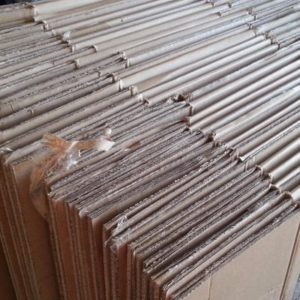Cardboard is one of the most common materials found in American homes due to the fact that almost anything you purchase comes in packaging made of cardboard. With the growth of home delivery, such as Amazon Prime, and groceries like Hello Fresh and Instacart, we have more packaging materials than ever in our homes. Luckily, most cities have a recycling program that accepts every type of cardboard, from egg cartons and shipping boxes from the mail to large corrugated cardboard from new appliances.
It is durable, light-weight, and relatively cheap, so it makes a great container for anything from food boxes, small appliances, to large furniture. Most cardboard waste can and should be recycled whenever possible. The good news is that cardboard is the most recycled of paper products, with a recycling rate consistently around 90% annually for several decades.
Corrugated cardboard is the highest grade of paper product, meaning it is durable and has long paper fibers. This makes it highly recyclable and a perfect paper product for recycling programs. The sheets of cardboard can be recycled into new cardboard shipping products, chipboard, cereal boxes, thinner paperboard, and much more. This product should never need to take up landfill space. With a bit of effort, people can eliminate this waste. We’ll provide the information and step-by-step instructions to recycle that cardboard box responsibly.
Where Can I Recycle Cardboard Near Me?
Most local recycling centers will accept all cardboard and paperboard products. Keep in mind that cardboard needs to be clean and dry. Food-stained or wet cardboard cannot be recycled. Some facilities will pay for cardboard, while others will accept it without compensation. One thing to keep in mind is that the payout for cardboard is not very much unless you have a significant amount. It is often businesses that do a lot of shipping and/or receiving and have pallets of recycled cardboard that fall into this category.
If your city offers a curbside recycling service for recyclable items, then you should certainly break down your cardboard boxes and place them into recycling bins. This is the easiest and most convenient way to recycle cardboard at home. If your home is located in an area where you do not have recycling or if you have a large amount of cardboard to recycle, you may want to locate a local recycling center. Most will accept clean unsoiled cardboard.
Nevertheless, you should still make an effort to recycle as much cardboard as you can. Recycling cardboard keeps it out of landfills and saves valuable space for items that are not able to be recycled. There is also a great deal of energy savings accomplished when using recycled vs. new cardboard.
Steps to Recycling Cardboard:
- Remove all other materials such as plastic, bubble wrap, and packing peanuts from the boxes.
- You will need to break down the boxes so they are flat. Use scissors or a knife to cut tape and flatten down boxes.
- For large boxes, you may need to use heavy scissors, a box cutter, or a utility knife to cut the flattened boxes in half so they can fit into recycling containers.
- Cut out any food soiled parts of cardboard, such as oil stains or food from pizza boxes.This cardboard cannot be recycled.
- Keep cardboard dry. If your recycling bin has a lid, you should be fine. If it does not, then make sure to wait and set the cardboard out right before pickup so the cardboard doesn’t get wet from rain or fog.
- If you’re taking it to a cardboard recycling center, then you may need to separate corrugated cardboard from the boxboard. The thicker, heavy pieces are corrugated cardboard, and the paperboard includes shoe boxes, cereal boxes, and internal packaging pieces.
- Some types of cardboard have a special wax or plastic lining, such as those used in storing liquids. These should be separated as they go through a different process for recycling.
- It is not necessary to remove tape or packing labels as these will be separated and removed during the recycling process.

Why You Should Recycle Cardboard
By recycling paperboard and cardboard, we can help promote sustainability by reducing the amount of natural resources used to create new products.
Some cardboard boxes are made from 100% recycled material, while others are made up of as much as 80%-90% recycled materials. This may not seem very significant at first, but here are some facts that put this into perspective.
Cardboard Recycling Facts
- The number of boxes used in the average home move equals more than 1/2 of a one-ton pine tree.
- To create 1 ton of virgin cardboard would require processing 3 tons of trees.
- The energy required to make boxes from recycled cardboard is 25% less than the amount of energy used in making new cardboard boxes.
- An average American uses 7 trees worth of cardboard, paper, and products made from trees.
- 1.1 barrels of oil is saved for every one ton of cardboard recycled.
- Recycling 1 ton of cardboard saves 7,000 gallons of water!
These facts alone should convince you to do your part for the environment, sustainability, and saving resources!
How are Cardboard Boxes Recycled?
Cardboard boxes are normally recycled to make new products. After the boxes are collected, they are taken in bulk to a recycling facility to be sorted by type and then shredded. There are different grades of cardboard based on weight and type of paper used on each layer.
Then they are put in a special solution made of water to help them decompose faster. This is referred to as pulping. This is also when any tape, staples, stickers or labels are removed. The pulper runs the fiber through special filters that remove the dye or ink, and other contaminants.
Then, the pulp is mixed with about 25 percent new wood chips. The pulp mixture is then run through large dryers to remove any moisture before it is run through machines to create new cardboard boxes or other paper goods. The fibers are pressed and rolled on a conveyor belt into new paper. The whole process can take less than two weeks!
Frequently Asked Questions:
Do I need to remove tape and labels from cardboard before recycling?
No. You do not need to remove the tape or shipping labels from boxes.
Why can’t wet cardboard be recycled?
Cardboard must be dry in order to recycle, which may seem strange since water is used in the recycling process. When the cardboard gets wet and then subsequently dries, it changes the fibers, making them stiffer. Paper mills also don’t want to pay for wet cardboard as this will be heavier than dry.
Can I recycle my pizza box?
Yes. If the box is free of oil, grease, or food waste. Pizza boxes are a big culprit of recycling contamination due to the food and/or oils left on pizza boxes. While the intentions are good, this is a very common mistake in recycling. Usually the top of a pizza box is free from food and debris, so you can cut off the top and recycle that portion if it is clean and dry. If there are oil stains, then it has to be thrown away in the regular trash. Error on the side of caution, because contamination of your whole bin of paper recycling isn’t worth that one pizza box staying out of the trash.

Can money be made by recycling cardboard?
Large paper mills will purchase cardboard in bulk, but it must be separated from other types of paper. If your business uses a lot of cardboard, such as a retail store or restaurant, you may want to contact a recycling paper mill to inquire about an arrangement. As a regular consumer it is highly unlikely that you will find a company willing to pay you for your paper recycling.
Do any states require cardboard recycling?
Pennsylvania and New Jersey, as well as Washington, D.C. have passed legislation requiring paper products to be recycled.
